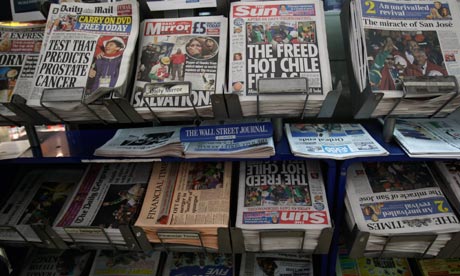
An "industry" in one breath, a "profession" in the next. But, in judicial inquiries, parliamentary debates and committee hearings, it is always "the press". One noun covers all. Meanwhile, back at the ranch, Dickie Desmond is hating the "fat butcher" Dacre and everyone else is hating Dickie: the Mail and the Telegraph are at daggers drawn, as usual: the Guardian is treated sorrowfully, as though it's burped in church; and Rupert is a pariah come to dust, unless he's paying your wages. In short, there seems to be no solidarity, no togetherness, no collective will. Just loathing.
Except in one changing regard, that is. Welcome to Newsworks 2012, which used to be the Newspaper Marketing Agency in 2011. No Desmond, of course, and no FT – but the Guardian and the Sun standing side by side, the Mail cuddling up with the Mirror, the Times and the Indy paying up to tell advertisers how well print – all print – can work for them. And now Newsworks adds an extra twist. Renamed and reinvigorated under a new director, Rufus Olins, it wants to show how "newsbrands", online as well as on paper, can do a bounding, buoyant job. Forget gloom or retrenchment. There are some terrific facts to hang onto here.
Is the audience for newsbrands going down (as everyone says) or up? Silly question. In 2007, print and digital news in Britain accounted for 22.6 million readers; now it's 24.4 million. Newsbrands (mainly in print) best reach people buying a car for more than £20,000, taking out private health insurance, rating ABC1. They tap the interests of 6 million more women a week than all women's magazines put together. Young people – between 18 and 34 – make up 25% of print readership (and possibly 37% of the digital audience). So brands, trusted and often historic brands, are splendid. They define whole sections of society – Guardian readers, Telegraph readers – and they're active, dynamic; not morose, not doomed.
Why, then, do journalists and pundits trudge around continually claiming that the end of their world is nigh? Because they don't understand? Because they don't believe in their own strength? Ah! there's the rub.
Take those 24.4 million readers. They're an "estimated figure", says Newsworks, since "no single survey measures all platforms in detail". You have to put together National Readership Survey, ABCe and TGI Net figures for readers who follow screens but never turn pages to validate the claim. It's a reasonable, well-argued bet. But, crucially, it is a bet: a complex calculation rather than a simple fact. And that's what's surprisingly stupid about newsworking the net.
In theory, it's an entirely mechanical process: advertisers ought to know exactly what they're getting, one click at a time. In practice, it's a melee of competing methodologies and claims (usually by analysis companies who say that only they add this or that dimension). Nine different research groups are thanked at the back of Newswork's first brochure. They may all be necessary; but they bring perplexity with them as their slideshows begin.
ABC in America has just done the seemingly strategic thing and fused print and digital results together. ABC in the UK has just split Saturday sales and weekday sales into two separate sets of statistics (and paved the way, one guesses, for day-by-day figures on print circulation, which can't sensibly be replicated for digital yet). But where's real transparency amid so much contradictory change? At the moment, the more advertisers are told, the more complicated everything gets.
There may be better progress after this autumn if, as rumoured, ABC in Britain begins to go the US route with consolidated figures. But those results still won't fit neatly with parallel findings from comScore or Nielsen, if present experience is any guide – while even the basic ABCe findings here are becoming an infuriating morass of inconsistency, sometimes giving daily figures, sometimes monthly, sometimes posting N/A in column after column. So Mail Online has 90,000,000 unique visitors; so the Guardian's April figures were up a staggering 61% year on year; so scratch around for the other information you need.
Of course, newspapers can do their own work and make their own pitches, but surely "the industry" has an interest in behaving like one – in this area at least. Olins's first exercise in togetherness shows just how much scope for positive selling there is (and perhaps how talking down print too glibly can be a huge mistake). Sniping helps nobody; ideological battles over paywalls and the like butter few parsnips in Mad Men world. But if Newsworks is going to work, it will need to achieve something in unity that only Leveson seems to think exists: to take a scatter of competing egos and grinding axes and make them an industry.

